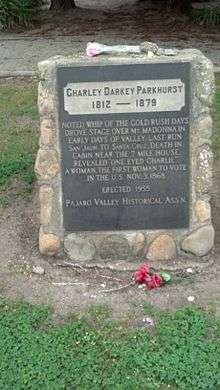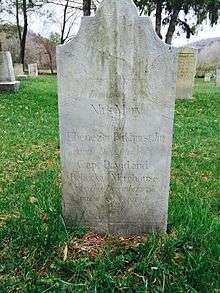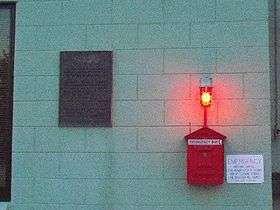Charley Parkhurst
Charley Darkey Parkhurst, born Charlotte Darkey Parkhurst (1812–1879),[1] also known as One Eyed Charley or Six-Horse Charley, was an American stagecoach driver, farmer and rancher in California. Born and raised a girl in New England, Parkhurst ran away as a youth, taking the name Charley and began living as a man. He started work as a stable hand and learned to handle horses, including to drive coaches drawn by multiple horses. He worked in Massachusetts and Rhode Island, traveling to Georgia for associated work.
Charley Darkey Parkhurst | |
|---|---|
| Born | 1812 |
| Died | December 18, 1879 |
| Resting place | Pioneer Cemetery, Watsonville, California |
| Occupation | Stagecoach driver, farmer, rancher |


In his late 30s, Parkhurst sailed to California following the Gold Rush in 1849; there he became a noted stagecoach driver. In 1868, he may have been the first female to vote in a presidential election in California.[1][2] After his death was it was discovered that his sex was female and he had given birth at an earlier time.[3]
Life and career
Charley Parkhurst was born Charlotte Darkey Parkhurst[1][2] in 1812 in Sharon, Vermont, to Mary (Morehouse) Parkhurst and Ebenezer Parkhurst.[4] Parkhurst had two siblings, Charles D. and Maria. Charles D. was born in 1811 and died in 1813. The mother, Mary, died in 1812. Some time after Charles D. died, Charlotte and Maria were taken to an orphanage in Lebanon, New Hampshire. (Some sources say Charlotte was born there.[1]) They were raised under the care of Mr. Millshark.
Parkhurst ran away from the orphanage at age 12, adopted the name Charley, and assumed a masculine presentation. According to one account, Parkhurst soon met Ebenezer Balch, who had a livery stable in Providence, Rhode Island. He took what he thought was an orphaned boy under his care and returned to Rhode Island.[1] Treating Parkhurst like a son, Balch taught him to work as a stable hand and gradually with the horses. He developed an aptitude with horses, and Balch taught him to drive a coach, first with one, then four, and eventually six horses. Parkhurst worked for Balch for several years. He may have gotten to know James E. Birch, who was a younger stagecoach driver in Providence.
In 1848, the 21-year-old Birch and his close friend Frank Stevens went to California during the Gold Rush to seek their fortunes. Birch soon began a stagecoach service, starting as a driver with one wagon. He gradually consolidated several small stage lines into the California Stage Company.
Seeking other opportunities as well, Parkhurst, in his late 30s, also left for California, sailing on the R.B. Forbes from Boston to Panama;[5] travelers had to cross the isthmus overland and pick up other ships on the west coast. In Panama, Parkhurst met John Morton, returning to San Francisco where he owned a drayage business; Morton recruited the driver to work for him.[6] Shortly after reaching California, Parkhurst lost the use of one eye after a kick from a horse, leading to his nickname of One Eyed Charley or Cockeyed Charley.
Later Parkhurst went to work for Birch, where he developed a reputation as one of the finest stage coach drivers (a "whip") on the West Coast. This inspired another nickname for him, Six-Horse Charley. He was ranked with "Foss, Hank Monk and George Gordon" as one of the top drivers of the time.[7] Stagecoach drivers were also nicknamed "Jehus," after a Biblical passage in Kings 9:20: "…and the driving is like the driving of Jehu the son of Nimshi; for he driveth furiously."[1][8]
Among Parkhurst's routes in northern California were Stockton to Mariposa, "the great stage route" from San Jose to Oakland, and San Juan to Santa Cruz.[7] Stagecoach drivers carried mail as well as passengers, and had to deal with hold-up attempts, bad weather, and perilous, primitive trails. As historian Charles Outland described the era, "It was a dangerous era in a dangerous country, where dangerous conditions were the norm."[9]
Seeing that railroads were cutting into the stagecoach business, Parkhurst retired from driving some years later to Watsonville, California. For fifteen years he worked at farming and lumbering in the winter. He also raised chickens in Aptos.[7]
He later moved into a small cabin about six miles from Watsonville, and suffered from rheumatism in his later years. Parkhurst died there on December 18, 1879, due to tongue cancer.[7]
Posthumous revelation
After Parkhurst died in 1879, neighbors came to the cabin to lay out the body for burial and discovered that his body appeared to be female. Rheumatism and cancer of the tongue were listed as causes of death. In addition, the examining doctor established that Parkhurst had given birth at some time. A trunk in the house contained a baby's dress.[3] The LA Times reported, "The discovery of her true sex became a local sensation,"[2] and was soon carried by national newspapers.
The obituary about Parkhurst from the San Francisco Call was reprinted in The New York Times on January 9, 1880, so the extraordinary driving career and the post-mortem discovery of Parkhurst's sex received national coverage. The headline was: "Thirty Years in Disguise: A Noted Old Californian Stage-Driver Discovered. After Death. To be a Woman."[7]
He was in his day one of the most dexterous and celebrated of the famous California drivers ranking with Foss, Hank Monk, and George Gordon, and it was an honor to be striven for to occupy the spare end of the driver's seat when the fearless Charley Parkhurst held the reins of a four-or six-in hand... Last Sunday [December 28, 1879], in a little cabin on the Moss Ranch, about six miles from Watsonville, Charley Parkhurst, the famous coachman, the fearless fighter, the industrious farmer and expert woodman died of the cancer on her tongue. She knew that death was approaching, but she did not relax the reticence of her later years other than to express a few wishes as to certain things to be done at her death. Then, when the hands of the kind friends who had ministered to her dying wants came to lay out the dead body of the adventurous Argonaut, a discovery was made that was literally astounding. Charley Parkhurst was a woman.[7]
The article noted how unusual it was that Parkhurst could have lived so long with no one discovering his biological sex, and to "achieve distinction in an occupation above all professions calling for the best physical qualities of nerve, courage, coolness and endurance, and that she should add to them the almost romantic personal bravery that enables one to fight one's way through the ambush of an enemy..." was seen to be almost beyond believing, but there was ample evidence to prove the case.[7]
1868 vote

The Santa Cruz Sentinel of October 17, 1868, lists Charles Darkey Parkhurst on the official poll list for the election of 1868. There is no record that Parkhurst actually cast a vote.[10] If he had voted, Parkhurst may have been the first female to vote in a presidential election in California. Local legend and Parkhurst's gravestone claims that Parkhurst was "the first woman to vote in the U.S."[11]
Legacy and honors
- The fire station in Soquel, California, has a plaque reading:
The first ballot by a woman in an American presidential election was cast on this site November 3, 1868, by Charlotte (Charley) Parkhurst who masqueraded as a man for much of her life. She was a stagecoach driver in the mother lode country during the gold rush days and shot and killed at least one bandit. In her later years he drove a stagecoach in this area. She died in 1879. Not until then was she found to be female. She is buried in Watsonville at the pioneer cemetery.
- In 1955, the Pajaro Valley Historical Association erected a monument at Parkhurst's grave, which reads:[12]
Charley Darkey Parkhurst (1812-1879) Noted whip of the gold rush days drove stage over Mt. Madonna in early days of Valley. Last run San Juan to Santa Cruz. Death in cabin near the 7 mile house. Revealed 'one eyed Charley' a woman. First woman to vote in the U.S. November 3, 1868.
Representation in popular culture
- The Autry National Center of Los Angeles had a series of programs and events, entitled Out West, from 2009-2010, that included exhibits, lectures, films and other material about homosexual, bisexual and transgender people's contributions to the Old West. Charley Parkhurst was one of the individuals featured in this series.[2]
- Pam Muñoz Ryan wrote a fictionalized biography of Charley Parkhurst's life for children, titled Riding Freedom (1999). It is illustrated by Brian Selznick.[15]
- Fern J. Hill wrote a fictional memoir based on Parkhurst's life, Charley's Choice: The Life and Times of Charley Parkhurst (2008).[16]
- Karen Kondazian wrote a historical fiction novel, The Whip (2012), based loosely on the life of Charley Parkhurst.[17]
- On March 13, 1958 during the sixth season of the television series Death Valley Days, the episode "Cockeyed Charlie Parkhurst" aired. It was loosely based on his life. Frank Gerstle played the role of Charley.
- Janice Holt Giles had Charlie Parkhurst as a character in the novel Six Horse Hitch, a historical fiction novel about stage coaching covering the period from 1859-1869. Published in June 1969 by Houghton Mifflin company.
- There seems to be a brief reference to Parkhurst in a line from Django Unchained around 1 hour and 1 minute in. King describes how Django could act as a slave-fighting expert to help him avoid suspicion and danger. Comes Django's reply: "They call that [a] One-Eyed Charley." The comedic parallel to a knowing contemporary audience is apparently that social mis-interpretations can still be used to one's advantage. This reading of the line presents an anachronism, however, because Parkhurst's revelatory obituary was not published till after his death in 1879, whereas the line is delivered in a (likely fictional/alternate) 1858.
References
- Kathi Bristow, "Those Daring Stage Drivers", 2008, California Dept. of Parks and Recreation, accessed 13 August 2014
- Ng, David (December 15, 2009). "'Out West' at the Autry examines the history of homosexuals and transgender people in the Old West". Los Angeles Times. Retrieved March 17, 2011.
- Thrapp, Dan L. (1991), Encyclopedia of Frontier Biography: P-Z, University of Nebraska Press, p. 1115, ISBN 0-8032-9420-4
- "dailyUV". dailyuv.com. Retrieved 2016-05-18.
- California’s Sesquicentennial Wagon Train Organization. "Reining a Team Through Yosemite," California: California Sesquicentennial Board of Directors; California: California’s Sesquicentennial Wagon Train, Mariposa Board of Directors, 1999, pp. 107-108
- Craig MacDonald, Cockeyed Charley Parkhurst: The West’s Most Unusual Stage Whip, Colorado: Filter Press, 1973, p. 22
- "Thirty Years in Disguise", Correspondence of the San Francisco Call, carried in New York Times, 9 January 1880, accessed 12 August 2014
- Oscar Osburn Winthur, Via Western Express & Stagecoach, California: Stanford University Press, 1947
- Ward McAfee, Review: Charles F. Outland, Stagecoaching on El Camino Real, Los Angeles to San Francisco: 1861-1901, San Diego Historical Society Quarterly, Summer 1974, Volume 20, Number 3, accessed 13 August 2014
- Hall, Daniel M. (March 5, 2003), "The Strange Life and Times of Charley Parkhurst", Metro Santa Cruz, retrieved 2009-02-08
- The New York Times
- Beal, Richard A. (1991), Highway 17: The Road to Santa Cruz, Aptos, California: Pacific Group, pp. 71–2, ISBN 0-9629974-0-4
- Current Housing Projects, 2006, archived from the original on 2009-06-18, retrieved 2009-05-24
- Fajardo, Aldwin (May 13, 2008), "Fairy Tale Transformation for a Notorious Aptos Trailer Park", Mid-County Post, archived from the original on July 14, 2011, retrieved 2009-05-24
- Review of Pam Muñoz Ryan's Riding Freedom, Publisher's Weekly, reprinted at Amazon.com
- Fern J. Hill, Charley's Choice: The Life and Times of Charley Parkhurst, Infinity Publishing, 2008
- Kondazian, Karen (2012), The Whip, Hansen Publishing Group, ISBN 978-1601823021
Further reading
- Harris, Gloria G. and Hannah S. Cohen. Women Trailblazers of California: Pioneers to the Present, The History Press, 2012 (no sources or footnotes)
- Outland, Charles F. Stagecoaching on El Camino Real, American Trails Series, Glendale, California: Arthur H. Clarke Company, 1973
- Pryor, Alton. Fascinating Women in California History, Roseville, California: Stagecoach Publishing, 2003, ISBN 0-9660053-9-2, self-published (no sources or footnotes)
- Southwick, Albert B. (published 1970 in Carriage Journal), republished in Selected Writings Volume II (2014) ISBN 9781501015557, self-published (no sources or footnotes)
External links
- "Charley Darkey Parkhurst had a secret", Santa Cruz Sentinel, 8 October 2006
- "The Strange Life and Times of Charley Parkhurst", Metro Active
- "Survival with Style: The Women of the Santa Cruz Mountains"
- The New York Times' 1880 Obituary
- A Conversation about Charley Parkhurst with Karen Kondazian and Peter Robinson on YouTube
- Short radio episode reading news article of the day about Parkhurst, California Legacy Project
- "The Life and Death of Fearless Stagecoach Driver, Charley Parkhurst", 4 May 2016